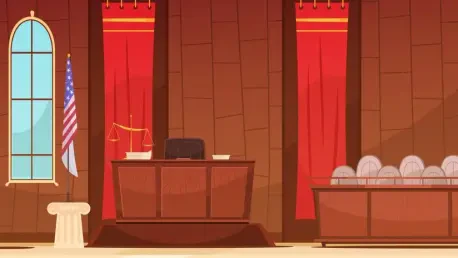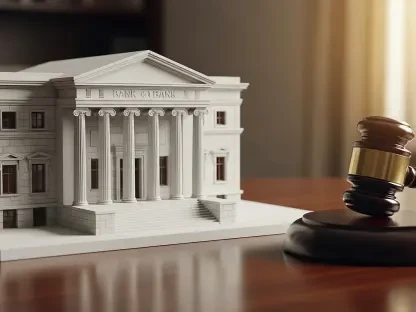Introduction to a Pivotal Trade Policy Debate
The landscape of U.S. trade policy stands at a critical juncture as the balance of power over tariffs—a tool that shapes economic fortunes and global relations—hangs in the balance. With tariffs influencing everything from the price of household goods to the competitiveness of domestic industries, a landmark Supreme Court case scheduled for this year has captured the attention of economists, policymakers, and business leaders alike. This case, centered on the use of emergency powers to impose tariffs, could redefine the boundaries of presidential authority and reshape how trade decisions are made, prompting a deeper examination of democratic accountability and economic stability in an interconnected world.
The Evolution of Tariff Authority in the United States
The authority to set tariffs in the United States has deep constitutional roots, with Article I, Section 8 of the Constitution explicitly granting Congress the power to impose taxes, duties, and imposts. Historically, this meant that tariff policies, such as the infamous Smoot-Hawley Tariff Act of 1930, were crafted through legislative debate, reflecting the will of elected representatives. This framework ensured that trade measures, which often carry significant economic consequences, were subject to public scrutiny and deliberation.
Over time, however, this authority began to shift toward the executive branch, driven by landmark legislation like the Reciprocal Trade Agreement Act of 1934. This act marked a turning point by allowing the president to negotiate trade agreements and adjust tariffs within certain limits, a move prompted by the need for quicker responses to global economic challenges. Subsequent laws further expanded this delegation, reflecting a growing belief that the executive could act more decisively than an often-gridlocked Congress.
The driving forces behind this shift were both political and economic. Partisan deadlock made it difficult for Congress to pass specific trade measures without risking political fallout, while the complexities of international trade demanded rapid adjustments to protect national interests. As a result, lawmakers increasingly relied on broad statutes to grant the president flexibility, a trend that has shaped modern trade policy but raised questions about the erosion of legislative oversight.
The Upcoming Supreme Court Case on Presidential Powers
Scope and Significance of the Case
A highly anticipated Supreme Court case set for November 5 this year focuses on the use of the International Emergency Economic Powers Act, a Cold War-era law, to justify sweeping import tariffs without direct congressional approval. This case challenges the extent to which a president can invoke emergency powers to enact trade policies that impact vast sectors of the economy, from manufacturing to consumer goods. At its core, the dispute questions whether such authority aligns with constitutional principles that assign tariff powers to Congress.
The implications of this ruling extend far beyond legal interpretation, potentially altering the framework of U.S. trade policy for years to come. A decision affirming broad presidential power could solidify the executive’s role as the primary driver of tariff decisions, while a ruling in favor of congressional authority might prompt a reevaluation of existing emergency laws. This case represents a critical moment to address the balance between swift executive action and the democratic checks inherent in legislative control.
Potential Outcomes and Economic Impacts
The Supreme Court’s decision could take several forms, each with distinct consequences for executive power. If the court upholds the president’s ability to use emergency powers for tariffs, it may embolden future administrations to act unilaterally, bypassing congressional input on trade matters. Conversely, a ruling that limits such authority could force a return to legislative processes, potentially slowing trade responses but enhancing accountability.
Economically, the stakes are substantial, as tariffs directly influence market stability and consumer prices. Unchecked executive power might lead to sudden policy shifts, creating uncertainty for businesses reliant on predictable trade conditions, while also risking higher costs for everyday goods. Additionally, such actions could strain international trade relations, inviting retaliatory measures from key partners and disrupting global supply chains.
The ripple effects of this decision will likely be felt across industries, from agriculture to technology, as companies grapple with potential cost fluctuations and market access challenges. A balanced outcome that clarifies the scope of presidential authority while preserving congressional oversight could mitigate these risks, fostering a more stable environment for economic planning and international cooperation.
Challenges in the Current Trade Policy Framework
The current trade policy framework reveals significant gaps, particularly in the diminished role of congressional oversight. When tariff decisions are made unilaterally by the executive branch, there is a notable lack of democratic accountability, as elected representatives are sidelined from debates that affect their constituents. This disconnect undermines the transparency needed for policies that redistribute economic burdens and benefits across society.
Economic risks further compound these governance issues, as unilateral tariff decisions often lead to market unpredictability. Businesses struggle to plan investments or adjust supply chains when trade policies can shift without warning, while consumers face the burden of price volatility on essential goods. Moreover, such actions frequently provoke retaliatory tariffs from other nations, escalating trade tensions and harming U.S. exporters in competitive global markets.
Judicial intervention, while sometimes necessary, is not an adequate substitute for legislative action in addressing these challenges. Courts lack the expertise and mandate to craft nuanced economic policies, often issuing rulings that are too narrow or broad to address the complex trade-offs involved. This limitation highlights the urgent need for a more robust system where Congress actively shapes trade policy through deliberate and informed processes.
Regulatory and Constitutional Dimensions of Tariff Powers
At the heart of the tariff debate lies the constitutional foundation that assigns Congress the authority to regulate commerce and impose duties. This clear mandate was intended to ensure that trade policies reflect the diverse interests of the nation, as represented by elected lawmakers. However, the delegation of these powers to the executive through various statutes has blurred the lines of responsibility, creating legal ambiguity around the scope of presidential action.
Emergency laws, such as the International Emergency Economic Powers Act, have played a significant role in expanding executive authority, often under the justification of national security or economic crises. While these laws provide flexibility in times of urgent need, their broad application to routine trade matters raises concerns about overreach. Without precise statutory guidelines, the risk of misinterpretation or abuse of power remains a pressing issue.
The Supreme Court’s upcoming ruling offers an opportunity to clarify these legal boundaries and reinforce the importance of congressional intent in delegating authority. A decision that emphasizes clear statutory limits could prevent future overreach, ensuring that emergency powers are used only in genuine crises. Such clarity would strengthen the constitutional framework while guiding policymakers in crafting laws that balance flexibility with accountability.
Future Directions for U.S. Trade Policy
Restoring congressional primacy in tariff-setting requires targeted legislative reforms and enhanced oversight mechanisms. Proposals to mandate regular reviews of trade policies, coupled with requirements for public reporting on economic impacts, could reinstate Congress as the central authority on tariffs. These measures would ensure that trade decisions are grounded in data and aligned with national priorities, rather than subject to unilateral executive discretion.
Transparency and public input are equally critical in shaping effective trade policies that reflect broader societal needs. Establishing platforms for stakeholder engagement, alongside independent economic analyses, can provide lawmakers with comprehensive insights into the consequences of tariff measures. This approach would foster trust in the decision-making process, ensuring that policies are not only responsive but also equitable across diverse sectors.
Looking globally, practices in regions like the European Union offer potential models for balanced trade governance. The EU’s system, which emphasizes collective decision-making and parliamentary oversight, demonstrates how authority can be distributed to maintain both efficiency and accountability. Adopting similar principles could guide the U.S. in reforming its trade policy framework, aligning it with democratic values while addressing the demands of a dynamic global economy.
Reflections and Path Forward
Looking back, the discourse surrounding presidential tariff powers reveals a profound shift in how trade policy has been governed, with congressional authority gradually ceded to the executive over decades. The Supreme Court case has become a focal point for debates on accountability, exposing the economic and democratic risks of unchecked power. Each dimension—historical, legal, and economic—underscores the complexity of balancing swift action with deliberative oversight.
Moving forward, actionable steps emerge as essential to recalibrating this balance. Congress needs to prioritize legislative reforms that reinstate its constitutional role, supported by structured processes for tariff evaluation and public consultation. Establishing bipartisan committees to monitor trade impacts could provide a foundation for informed policy, reducing reliance on emergency powers.
Additionally, fostering international dialogue to anticipate and mitigate trade disputes offers a proactive solution. By integrating diplomatic strategies into trade governance, the U.S. could minimize retaliatory risks while building stronger global partnerships. These steps, rooted in transparency and collaboration, pave the way for a trade policy framework that prioritizes both economic stability and public trust, ensuring decisions reflect the nation’s collective interests.









